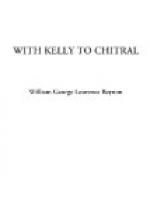We went to sleep that night with the blissful consciousness that the next day was a halt at any rate, and I think we needed the rest. We had put on our least ragged coats to march in and make as brave a show as possible, but our kit generally was in a pretty disreputable state, and there was a good deal of work wanted in the laundry line. Most of us, also, had misgivings about our boots. I was reduced to choosing between boots with large holes in the soles or chuplies mended with string; the boots I kept for show days, as the holes didn’t show, and the chuplies for ordinary work. Most of the other officers were much in the same plight.
So ended the march of Colonel Kelly’s column to Chitral. Our record, on the whole, was not bad, though, of course, judging by actual distance, we had not done much; it was more the difficult nature of the ground and the altitude at which some of it was done that lent interest to the march, and I am unfeignedly glad my luck caused me to participate in it.
The next day the Kashmir troops of the garrison came out and camped with us, and revelled in the fresh air after the poisonous atmosphere of the fort. Poor chaps! they were walking skeletons, bloodless, and as quiet as the ghosts they resembled, most of them reduced to jerseys and garments of any description, but still plucky and of good heart. They cheered up wonderfully in a few days with good fresh air and sleep, and marched from Chitral quite briskly when they left.
The next day I again went round the fort and got some photos, which follow. One of the British officers of the garrison beneath the gun tower, which was set on fire, and during the extinguishing of which Surgeon-Major Robertson, the British agent, was wounded by a Snider bullet. There is also the loophole, afterwards made, from which a sentry inside the tower could fire at anyone within a few feet. Then I got Harley to show me the site of his sortie, and pretty grisly the place looked, but unfortunately the photograph I took, showing the mine lying open like a ditch to the foot of the tower, was a “wrong un.” But I succeeded in getting one showing the mouth of the mine, with the excavated earth.
Then I took one of the sangars from the interior, with the little shelters used by the Pathans when not amusing themselves with rifle practice. The water tower is just visible through the foliage.
Then I took a photo of the fort from the corner by the gun tower looking towards the musjid, which is shown in a photo at the beginning of the book, but taken in more peaceful times. It shows the bridge in the distance, which the fire of the Sikhs made too hot for the Chitralis, who had to cross over the hills in the daytime.
Then I took Harley and the two native officers of the 14th Sikhs, Subadar Gurmuskh Singh and Jemadar Atta Singh. Atta Singh put on white gloves to grace the occasion, but evidently trembled violently during the exposure.




